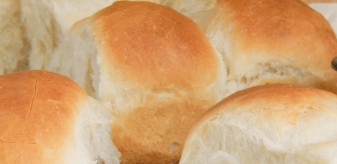



Today I propose to try airy, tender, aromatic and very tasty potato buns. No, they don't have the characteristic potato flavor at all. The finished baked goods are fluffy and light thanks to special natural additives. Serve fresh potato buns with your first courses, use for sandwiches, or simply eat with milk. It will be delicious, I promise!
It is due to the potato broth and boiled potatoes that the crumb of these homemade baked goods will be incredibly soft and fluffy. To do this, cook about three medium-sized potatoes peeled from the skin in unsalted water until fully cooked, after which we measure out the required amount of broth and boiled root vegetables. If you want to make dessert buns, add a couple more tablespoons of granulated sugar. You can flavor the dough with vanilla or vanilla sugar.
Of the specified number of ingredients, there will be 9 fairly large potato buns. If you want, you can make as much as you like - just divide the dough into the required number of pieces. Ready-made baked goods remain fresh for a long time, do not stale or mold within 5 days. Try this simple recipe: Perhaps it is the potato buns that will win the hearts of your family and you will bake them every week!

Today I propose to try airy, tender, aromatic and very tasty potato buns. No, they don't have the characteristic potato flavor at all. The finished baked goods are fluffy and light thanks to special natural additives. Serve fresh potato buns with your first courses, use for sandwiches, or simply eat with milk. It will be delicious, I promise!
It is due to the potato broth and boiled potatoes that the crumb of these homemade baked goods will be incredibly soft and fluffy. To do this, cook about three medium-sized potatoes peeled from the skin in unsalted water until fully cooked, after which we measure out the required amount of broth and boiled root vegetables. If you want to make dessert buns, add a couple more tablespoons of granulated sugar. You can flavor the dough with vanilla or vanilla sugar.
Of the specified number of ingredients, there will be 9 fairly large potato buns. If you want, you can make as much as you like - just divide the dough into the required number of pieces. Ready-made baked goods remain fresh for a long time, do not stale or mold within 5 days. Try this simple recipe: Perhaps it is the potato buns that will win the hearts of your family and you will bake them every week!
Sign up to receive email updates on new recipes.